Chapter 2: Capital budgeting and basic investment appraisal techniques
Chapter learning objectives
Upon completion of this chapter you will be able to:
- define and distinguish between capital and revenue expenditure
- distinguish between expenditure on non-current assets and working capital
- describe the capital budgeting process
- explain the role of investment appraisal in the capital budgeting process
- explain the relationship between the capital budgeting process and the development of corporate strategy
- define a relevant cash flow (and distinguish it from an accounting profit)
- identify and calculate relevant cash flows in a scenario
- calculate the payback period and use it to appraise an investment
- discuss the usefulness of payback as an investment appraisal method
- calculate return on capital employed (ROCE) (accounting rate of return) and use it to appraise an investment
- discuss the usefulness of ROCE as an investment appraisal method.
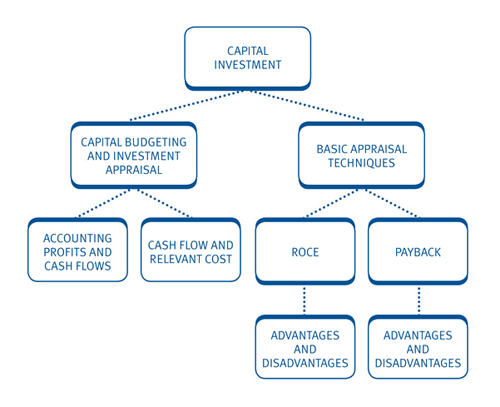
1 Capital investment
 When a business spends money on new non-current assets it is known ascapital investment or capital expenditure. Spending may be for:
When a business spends money on new non-current assets it is known ascapital investment or capital expenditure. Spending may be for:
- maintenance
- profitability
- expansion
- indirect purposes.
Spending is normally irregular and for large amounts. It is expected to generate long-term benefits.
 Other types of expenditure incurred by a business includes:
Other types of expenditure incurred by a business includes:
- Revenue expenditure â€" regular spending on the day-to-day running of the business where the benefit is expected to last for only one specific accounting period.
- Working capital investment â€" investment in short-term net assets (inventory, receivables and cash less short term payables).
 You must be able to distinguish between capital and revenue expenditure and expenditure on working capital.
You must be able to distinguish between capital and revenue expenditure and expenditure on working capital.

 Test your understanding 1 â€" Expenditure classification
Test your understanding 1 â€" Expenditure classification
An enterprise spends money on the following:
- annual rental payment for the warehouse
- a new fork-lift truck to replace one damaged in an accident
- increased inventory to fulfil a newly-won contract
- an automatic moulding machine to streamline a production process.
Identify the type of expenditure that each of the above represents.

2 Capital budgeting and investment appraisal
 A capital budget:
A capital budget:
- is a programme of capital expenditure covering several years
- includes authorised future projects and projects currently under consideration.
 One stage in the capital budgeting process is investment appraisal. This appraisal has the following features:
One stage in the capital budgeting process is investment appraisal. This appraisal has the following features:
- assessment of the level of expected returns earned for the level of expenditure made
- estimates of future costs and benefits over the project's life.

 Capital budgeting process
Capital budgeting process
The capital budgeting process (capital investment decision-making process) consists of a number of stages:

When a proposed capital project is evaluated, the costs andbenefits of the project should be evaluated over its foreseeable life.This is usually the expected useful life of the non-current asset to bepurchased, which will be several years. This means that estimates offuture costs and benefits call for long-term forecasting.
A 'typical' capital project involves an immediate purchase of anon-current asset. The asset is then used for a number of years, duringwhich it is used to increase sales revenue or to achieve savings inoperating costs. There will also be running costs for the asset. At theend of the asset's commercially useful life, it might have a 'residualvalue'. For example, it might be sold for scrap or in a second-handmarket. (Items such as motor vehicles and printing machines often have asignificant residual value.)
A problem with long-term forecasting of revenues, savings and costsis that forecasts can be inaccurate. However, although it is extremelydifficult to produce reliable forecasts, every effort should be made tomake them as reliable as possible.
- A business should try to avoid spending money on non-current assets on the basis of wildly optimistic and unrealistic forecasts.
- The assumptions on which the forecasts are based should be stated clearly. If the assumptions are clear, the forecasts can be assessed for reasonableness by the individuals who are asked to authorise the spending.

Two basic appraisal techniques are covered in this chapter:
More sophisticated methods of investment appraisal are dealt with in the next chapter.
 Examination questions may ask you to compare and contrast the use of these two basic techniques.
Examination questions may ask you to compare and contrast the use of these two basic techniques.
3 ROCE
This is also known as accounting rate of return (ARR).

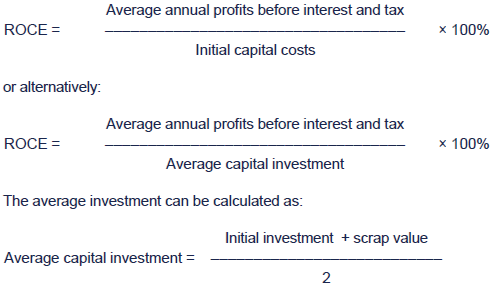
In the exam you should use the initial capital cost unless you aretold otherwise. However, the ROCE calculation based on the averagecapital investment is the method most commonly asked for in the exam.This will be made clear in the question.
Decision rule:
- If the expected ROCE for the investment is greater than the target or hurdle rate (as decided by management) then the project should be accepted.

 Test your understanding 2 â€" ROCE
Test your understanding 2 â€" ROCE
A project involves the immediate purchase of an item of plantcosting $110,000. It would generate annual cash flows of $24,400 forfive years, starting in Year 1. The plant purchased would have a scrapvalue of $10,000 in five years, when the project terminates.Depreciation is on a straight-line basis.
Determine the project's ROCE using:
(a)initial capital costs
(b)average capital investment


 Test your understanding 3 â€" ROCE
Test your understanding 3 â€" ROCE
A project requires an initial investment of $800,000 and then earns net cash inflows as follows:

In addition, at the end of the seven-year project the assets initially purchased will be sold for $100,000.
Determine the project's ROCE using:
(a)initial capital costs
(b)average capital investment.


 Initial capital cost
Initial capital cost
The initial capital cost could comprise any or all of the following:
- cost of new assets bought
- net book value (NBV) of existing assets to be used in the project
- investment in working capital
- capitalised R&D expenditure (NB ensure this is amortised against profit).

4 Advantages and disadvantages of ROCE
Advantages include:
- simplicity
- links with other accounting measures.
Disadvantages include:
- no account is taken of project life
- no account is taken of timing of cash flows
- it varies depending on accounting policies
- it may ignore working capital
- it does not measure absolute gain
- there is no definitive investment signal.
 Inthe examination it is important that you can discuss the features ofROCE as an investment appraisal technique, in addition to being able tocalculate it.
Inthe examination it is important that you can discuss the features ofROCE as an investment appraisal technique, in addition to being able tocalculate it.

 Advantages and disadvantages of ROCE
Advantages and disadvantages of ROCE
Advantages
Simplicity â€" being based on widely-reported measures of return(profits) and asset (balance sheet values), it is easily understood andeasily calculated.
Links with other accounting measures â€" annual ROCE, calculated toassess a business or sector of a business (and therefore the investmentdecisions made by that business), is a widely used measure. It isexpressed in percentage terms with which managers and accountants arefamiliar.
Disadvantages
It fails to take account of either the project life or the timingof cash flows within that life. This therefore ignores the time value ofmoney (see next chapter).
It will vary with specific accounting policies, and the extent towhich project costs are capitalised. Profit measurement is thus'subjective', and ROCE figures for identical projects would vary frombusiness to business.
It might ignore working capital requirements.
Like all rate of return measures, it is not a measurement of absolute gain in wealth for the business owners.
There is no definite investment signal. The decision to invest ornot remains subjective in view of the lack of an objectively set targetROCE.

5 Accounting profits and cash flows
 In capital investment appraisal it is more appropriate to evaluate future cash flows than accounting profits, because:
In capital investment appraisal it is more appropriate to evaluate future cash flows than accounting profits, because:
- profits cannot be spent
- profits are subjective
- cash is required to pay dividends.

 Profits versus cash flows
Profits versus cash flows
Cash flows are a better measure of the suitability of a capital investment because:
- cash is what ultimately counts â€" profits are only a guide to cash availability: they cannot actually be spent
- profit measurement is subjective â€" the time period in which income and expenses are recorded, and so on, are a matter of judgement
- cash is used to pay dividends â€" dividends are the ultimate method of transferring wealth to equity shareholders.
In practice, the cash flow effects of a project are likely to besimilar to the project's effects on profits. Major differences in cashand profit flows will be linked to the following:
- changes in working capital
- asset purchase and depreciation
- deferred taxation
- capitalisation of research and development expenditure.

6 Cash flows and relevant costs
 For all methods of investment appraisal, with the exception of ROCE, only relevant cash flows should be considered. These are:
For all methods of investment appraisal, with the exception of ROCE, only relevant cash flows should be considered. These are:
- future
- incremental
- cash-based.
Ignore:
- sunk costs
- committed costs
- non-cash items
- allocated costs.

 Relevant costs
Relevant costs
The only cash flows that should be taken into consideration in capital investment appraisal (with the exception of ROCE) are:
- cash flows that will happen in the future, and
- cash flows that will arise only if the capital project goes ahead.
These cash flows are direct revenues from the project and relevantcosts. Relevant costs are future costs that will be incurred or saved asa direct consequence of undertaking the investment.
- Costs that have already been incurred are not relevant to a current decision. For example, suppose a company makes a non-returnable deposit as a down payment for an item of equipment, and then reconsiders whether it wants the equipment after all. The money that has already been spent cannot be recovered and so is not relevant to the current decision about obtaining the equipment.
- Costs that will be incurred anyway, whether or not a capital project goes ahead, cannot be relevant to a decision about investing in the project. Fixed cost expenditures are an example of 'committed costs'. For the purpose of investment appraisal, a project should not be charged with an amount for a share of fixed costs that will be incurred in any event.
- Non-cash items of cost can never be relevant to investment appraisal. In particular, the depreciation charges on a non-current asset are not relevant costs for analysis because depreciation is not a cash expenditure.
- Accounting treatment of costs is often irrelevant (e.g. depreciation, inventory valuation, methods of allocating overheads) because it has no bearing on cash flows, except to the extent that it may affect taxation payable. Overheads attributed to projects should, in the examination, be taken as absorbed figures unless specified otherwise. It should be assumed there is no change to actual overhead paid, and thus no relevant cash flow.


 Test your understanding 4 â€" Relevant costs
Test your understanding 4 â€" Relevant costs
A manufacturing company is considering the production of a new type of widget. Each widget will take two hours to make.
Fixed overheads are apportioned on the basis of $1 per labour hour.
If the new widgets are produced, the company will have to employ anadditional supervisor at a salary of $15,000 pa. The company willproduce 10,000 widgets pa.
What are the relevant cash flows?


 Additional question - Relevant costs
Additional question - Relevant costs
A company is evaluating a proposed expenditure on an item of equipment that would cost $160,000.
A technical feasibility study has been carried out by consultants,at a cost of $15,000, into benefits from investing in the equipment.
It has been estimated that the equipment would have a life of fouryears, and annual profits would be $8,000, after deducting annualdepreciation of $40,000 and an annual charge of $25,000 for a share ofthe existing fixed cost of the company.
What are the relevant cash flows for this?
The answer to this question can be found after the chapter summary diagram at the end of this chapter.

7 Payback method of appraisal
 The paybackperiod is the time a project will take to pay back the money spent onit. It is based on expected cash flows and provides a measure ofliquidity.
The paybackperiod is the time a project will take to pay back the money spent onit. It is based on expected cash flows and provides a measure ofliquidity.
Decision rule:
- only select projects which pay back within the specified time period
- choose between options on the basis of the fastest payback
Constant annual cash flows
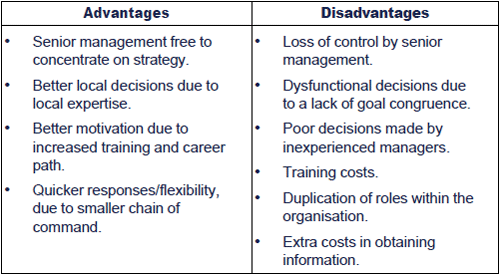

 Test your understanding 5 â€" Payback with constant annual cash
Test your understanding 5 â€" Payback with constant annual cash
An expenditure of $2 million is expected to generate net cash inflows of $500,000 each year for the next seven years.
What is the payback period for the project?

A payback period may not be for an exact number of years. Tocalculate the payback in years and months you should multiply thedecimal fraction of a year by 12 to the number of months.

 Test your understanding 6 â€" Payback in years and months
Test your understanding 6 â€" Payback in years and months
A project will involve spending $1.8 million now. Annual cash flows from the project would be $350,000.
What is the expected payback period?

Uneven annual cash flows
In practice, cash flows from a project are unlikely to be constant.Where cash flows are uneven, payback is calculated by working out thecumulative cash flow over the life of the project.

 Test your understanding 7 â€" Payback with uneven cash flows
Test your understanding 7 â€" Payback with uneven cash flows
A project is expected to have the following cash flows:
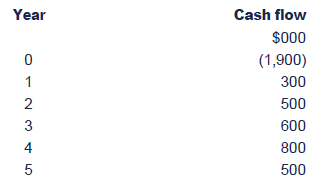
What is the expected payback period?


 Test your understanding 8 â€" Payback with uneven cash flows
Test your understanding 8 â€" Payback with uneven cash flows
Calculate the payback period in years and months for the following project:


8 Advantages and disadvantages of payback
 Advantages include:
Advantages include:
- it is simple
- it is useful in certain situations:
- rapidly changing technology
- improving investment conditions
- it favours quick return:
- helps company growth
- minimises risk
- maximises liquidity
- it uses cash flows, not accounting profit.
Disadvantages include:
- it ignores returns after the payback period
- it ignores the timings of the cash flows
- it is subjective â€" no definitive investment signal
- it ignores project profitability.
 Inthe examination it is important that you can discuss the features ofpayback as an investment appraisal technique as well as being able to dothe calculation.
Inthe examination it is important that you can discuss the features ofpayback as an investment appraisal technique as well as being able to dothe calculation.

 Advantages and disadvantages of payback
Advantages and disadvantages of payback
Advantages
Simplicity â€" as a concept, it is easily understood and is easily calculated.
Rapidly changing technology â€" If new plant is likely to bescrapped in a short period because of obsolescence, a quick payback isessential.
Improving investment conditions â€" When investment conditions areexpected to improve in the near future, attention is directed to thoseprojects which will release funds soonest, to take advantage of theimproving climate.
Payback favours projects with a quick return â€" It is often argued that these are to be preferred for three reasons:
(1)Rapid project payback leads torapid company growth, but in fact such a policy will lead to manyprofitable investment opportunities being overlooked because theirpayback period does not happen to be particularly swift.
(2)Rapid payback minimises risk(the logic being that the shorter the payback period, the less there isthat can go wrong). Not all risks are related to time, but payback isable to provide a useful means of assessing time risks (and only timerisks). It is likely that earlier cash flows can be estimated withgreater certainty.
(3)Rapid payback maximises liquidity – but liquidity problems are best dealt with separately, through cash forecasting.
Cash flows â€" Unlike the other traditional methods it uses cashflows, rather than profits, and so is less likely to produce an undulyoptimistic figure distorted by assorted accounting conventions whichmight permit certain costs to be carried forward and not affect profitinitially.
Disadvantages
Project returns may be ignored â€" cash flows arising after thepayback period are totally ignored. Payback ignores profitability andconcentrates on cash flows and liquidity.
Timing ignored â€" cash flows are effectively categorised aspre-payback or post-payback, but no more accurate measure is made. Inparticular, the time value of money is ignored.
Lack of objectivity â€" there is no objective measure as to whatlength of time should be set as the minimum payback period. Investmentdecisions are therefore subjective.
Project profitability is ignored â€" payback takes no account ofthe effects on business profits and periodic performance of the project,as evidenced in the financial statements. This is critical if thebusiness is to be reasonably viewed by users of the accounts.

Chapter summary
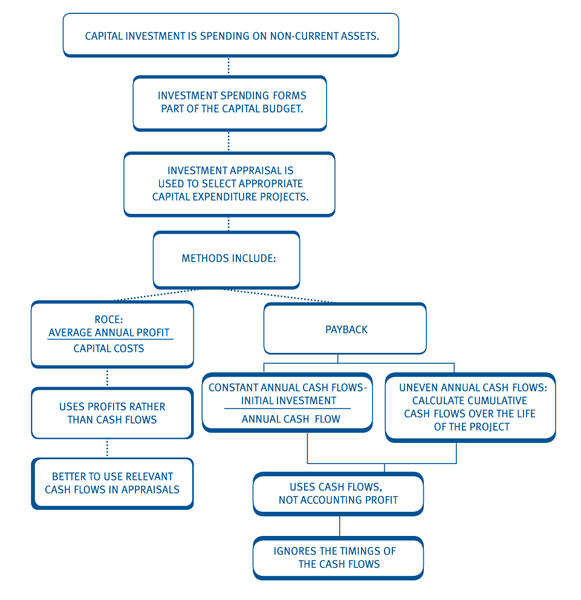

 Answer to additional question - Relevant costs
Answer to additional question - Relevant costs
The $15,000 already spent on the feasibility study is not relevant,because it has already been spent. (It is a 'sunk cost'). Depreciationand apportioned fixed overheads are not relevant. Depreciation is not acash flow and apportioned fixed overheads represent costs that will beincurred anyway.


Test your understanding answers

 Test your understanding 1 â€" Expenditure classification
Test your understanding 1 â€" Expenditure classification
- Annual rental payments for the warehouse are revenue expenditure. The benefit is only for that accounting period.
- The new fork-lift truck is a capital purchase. It is maintenance spending as it replaces one already owned but damaged.
- The increased inventory spending is an investment in working capital.
- The automatic moulding machine is also a capital expense. However since it was bought to streamline a production process, the purpose is profitability.


 Test your understanding 2 â€" ROCE
Test your understanding 2 â€" ROCE
Annual cash flows are taken to be profit before depreciation.
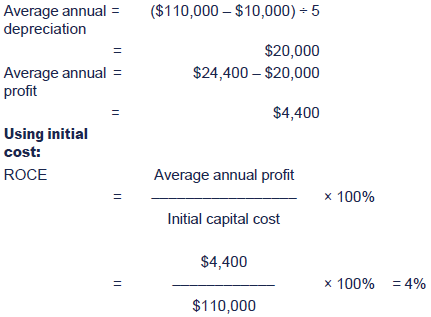
Using average capital investment:



 Test your understanding 3 â€" ROCE
Test your understanding 3 â€" ROCE
This uses profits rather than cash flows.
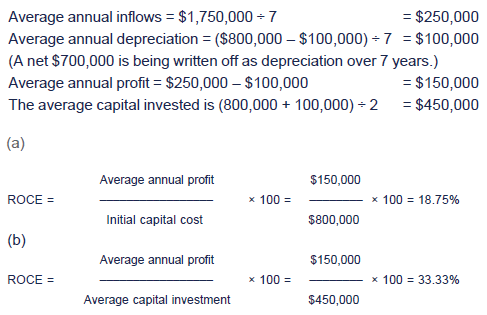


 Test your understanding 4 â€" Relevant costs
Test your understanding 4 â€" Relevant costs
Only the $15,000 salary is relevant. The fixed overheads are not incremental to the decision and should be ignored.


 Test your understanding 5 â€" Payback with constant annual cash
Test your understanding 5 â€" Payback with constant annual cash



 Test your understanding 6 â€" Payback in years and months
Test your understanding 6 â€" Payback in years and months

0.1429 of a year × 12 months = 1.7 months (rounded = 2 months)
The answer can therefore be stated as either:
- 5.1 years
- 5 years 2 months
assuming cash flows occur evenly throughout the year.


 Test your understanding 7 â€" Payback with uneven cash flows
Test your understanding 7 â€" Payback with uneven cash flows
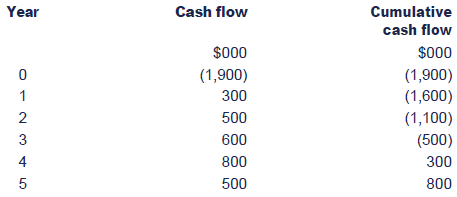
In the table above a column is added for cumulative cash flows forthe project to date. Figures in brackets are negative cash flows.
Each year's cumulative figure is simply the cumulative figure atthe start of the year plus the figure for the current year. Thecumulative figure each year is therefore the expected position as at theend of that year.
Payback is between the end of Year 3 and the end of Year 4 â€"that is during Year 4. This is the point at which the cumulative cashflow changes from being negative to positive. If we assume a constantrate of cash flow throughout the year, we could estimate that paybackwill be three years plus ($500/800) of Year 4. This is because thecumulative cash flow is minus $500 at the start of the year and the Year4 cash flow would be $800.
$500/800 = 0.625
Therefore payback is after 3.625 years.
Payback in years and months is calculated by multiplying thedecimal fraction of a year by 12 months. In this example, 0.625 years =7.5 months (0.625 × 12 months), which is rounded to 8 months. Sotherefore, payback occurs after 3 years 8 months.
Note that if cash flows were deemed to arise at the end of the year then the payback period would be 4 years.


 Test your understanding 8 â€" Payback with uneven cash flows
Test your understanding 8 â€" Payback with uneven cash flows
The payback period would be calculated as follows.
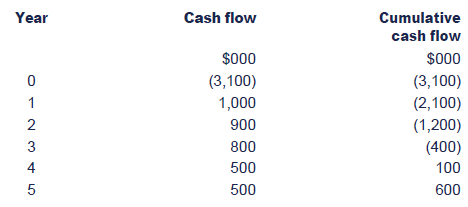
Payback is between the end of Year 3 and the end of Year 4, in other words during Year 4.
If we assume a constant rate of cash flow through the year, wecould estimate that payback will be three years, plus ($400/500) of Year4, which is 3.8 years.
0.8 years = 10 months (0.8 × 12)
We could therefore estimate that payback would be after 3 years 10 months.


| Created at 5/24/2012 4:09 PM by System Account (GMT) Greenwich Mean Time : Dublin, Edinburgh, Lisbon, London |
Last modified at 5/25/2012 12:54 PM by System Account (GMT) Greenwich Mean Time : Dublin, Edinburgh, Lisbon, London
| |
| |

 |
Rating : |  Ratings & Comments (Click the stars to rate the page) Ratings & Comments (Click the stars to rate the page) |
 |
Tags: | |

Recent Discussions |
There are no items to show in this view. |

![]() When a business spends money on new non-current assets it is known ascapital investment or capital expenditure. Spending may be for:
When a business spends money on new non-current assets it is known ascapital investment or capital expenditure. Spending may be for:![]() Other types of expenditure incurred by a business includes:
Other types of expenditure incurred by a business includes:![]() You must be able to distinguish between capital and revenue expenditure and expenditure on working capital.
You must be able to distinguish between capital and revenue expenditure and expenditure on working capital.
![]() Test your understanding 1 â€" Expenditure classification
Test your understanding 1 â€" Expenditure classification
![]() A capital budget:
A capital budget:![]() One stage in the capital budgeting process is investment appraisal. This appraisal has the following features:
One stage in the capital budgeting process is investment appraisal. This appraisal has the following features:
![]() Capital budgeting process
Capital budgeting process

![]() Examination questions may ask you to compare and contrast the use of these two basic techniques.
Examination questions may ask you to compare and contrast the use of these two basic techniques.![]()


![]() Test your understanding 2 â€" ROCE
Test your understanding 2 â€" ROCE

![]() Test your understanding 3 â€" ROCE
Test your understanding 3 â€" ROCE


![]() Initial capital cost
Initial capital cost
![]() Inthe examination it is important that you can discuss the features ofROCE as an investment appraisal technique, in addition to being able tocalculate it.
Inthe examination it is important that you can discuss the features ofROCE as an investment appraisal technique, in addition to being able tocalculate it.
![]() Advantages and disadvantages of ROCE
Advantages and disadvantages of ROCE
![]() In capital investment appraisal it is more appropriate to evaluate future cash flows than accounting profits, because:
In capital investment appraisal it is more appropriate to evaluate future cash flows than accounting profits, because:
![]() Profits versus cash flows
Profits versus cash flows
![]() For all methods of investment appraisal, with the exception of ROCE, only relevant cash flows should be considered. These are:
For all methods of investment appraisal, with the exception of ROCE, only relevant cash flows should be considered. These are:
![]() Relevant costs
Relevant costs

![]() Test your understanding 4 â€" Relevant costs
Test your understanding 4 â€" Relevant costs

![]() Additional question - Relevant costs
Additional question - Relevant costs
![]() The paybackperiod is the time a project will take to pay back the money spent onit. It is based on expected cash flows and provides a measure ofliquidity.
The paybackperiod is the time a project will take to pay back the money spent onit. It is based on expected cash flows and provides a measure ofliquidity.

![]() Test your understanding 5 â€" Payback with constant annual cash
Test your understanding 5 â€" Payback with constant annual cash

![]() Test your understanding 6 â€" Payback in years and months
Test your understanding 6 â€" Payback in years and months

![]() Test your understanding 7 â€" Payback with uneven cash flows
Test your understanding 7 â€" Payback with uneven cash flows


![]() Test your understanding 8 â€" Payback with uneven cash flows
Test your understanding 8 â€" Payback with uneven cash flows

![]() Advantages include:
Advantages include:![]() Inthe examination it is important that you can discuss the features ofpayback as an investment appraisal technique as well as being able to dothe calculation.
Inthe examination it is important that you can discuss the features ofpayback as an investment appraisal technique as well as being able to dothe calculation.
![]() Advantages and disadvantages of payback
Advantages and disadvantages of payback


![]() Answer to additional question - Relevant costs
Answer to additional question - Relevant costs


![]() Test your understanding 1 â€" Expenditure classification
Test your understanding 1 â€" Expenditure classification

![]() Test your understanding 2 â€" ROCE
Test your understanding 2 â€" ROCE



![]() Test your understanding 3 â€" ROCE
Test your understanding 3 â€" ROCE


![]() Test your understanding 4 â€" Relevant costs
Test your understanding 4 â€" Relevant costs

![]() Test your understanding 5 â€" Payback with constant annual cash
Test your understanding 5 â€" Payback with constant annual cash


![]() Test your understanding 6 â€" Payback in years and months
Test your understanding 6 â€" Payback in years and months


![]() Test your understanding 7 â€" Payback with uneven cash flows
Test your understanding 7 â€" Payback with uneven cash flows


![]() Test your understanding 8 â€" Payback with uneven cash flows
Test your understanding 8 â€" Payback with uneven cash flows

![]()
![]()
![]()
 Ratings & Comments (Click the stars to rate the page)
Ratings & Comments (Click the stars to rate the page) ![]()
![]()

0 Response to "Which Of The Following Is A Capital Budgeting Method That Ignores The Time Value Ofã¢â‚¬â€¹ Money?"
Post a Comment